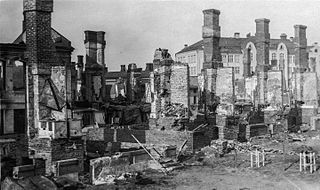
The Finnish Civil War was a civil war in Finland in 1918 fought for the leadership and control of the country between White Finland and the Finnish Socialist Workers' Republic during the country's transition from a grand duchy of the Russian Empire to an independent state. The clashes took place in the context of the national, political, and social turmoil caused by World War I in Europe. The war was fought between the Red Guards, led by a section of the Social Democratic Party, and the White Guards, conducted by the senate and those who opposed socialism with assistance late in the war by the German Imperial Army at the request of the Finnish civil government. The paramilitary Red Guards, which were composed of industrial and agrarian workers, controlled the cities and industrial centers of southern Finland. The paramilitary White Guards, which consisted of land owners and those in the middle and upper classes, controlled rural central and northern Finland, and were led by General C. G. E. Mannerheim.
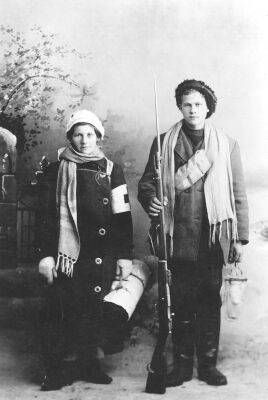
The Red Guards were the paramilitary units of the labour movement in Finland during the early 1900s. The Red Guards formed the army of Red Finland and were one of the main belligerents of the Finnish Civil War in 1918.

The Finnish Socialist Workers' Republic (FSWR), more commonly referred to as Red Finland, was a self-proclaimed socialist state in Finland during the Finnish Civil War from January to May 1918.

The Battle of Tampere was a 1918 Finnish Civil War battle, fought in Tampere, Finland from 15 March to 6 April between the Whites and the Reds. It is the most famous and the heaviest of all the Finnish Civil War battles. Today it is particularly remembered for its bloody aftermath as the Whites executed hundreds of capitulated Reds and took 11,000 prisoners placed in the Kalevankangas camp.

The Whites, or White Finland, was the name used to refer to the refugee government and forces under Pehr Evind Svinhufvud's first senate who opposed the "Reds", or the Finnish Socialist Workers' Republic, during the Finnish Civil War in 1918.

Kalevankangas Cemetery is a cemetery in the Kalevanharju district within the city of Tampere, Finland.

The Battle of Helsinki was a 1918 Finnish Civil War battle, fought in 12–13 April between the German troops and Finnish Whites against the Finnish Reds in Helsinki, Finland. Together with the battles of Tampere and Vyborg, it was one of the three major urban battles of the Finnish Civil War. The Germans invaded Helsinki despite the opposition of Finnish White Army leader Carl Gustaf Emil Mannerheim who wanted to attack the capital city with his own troops after Tampere had fallen on 6 April. However, the Germans had their own interest in taking Helsinki as quickly as possible and then moving further east towards the Russian border. The city had been under Red control for 11 weeks since the beginning of the war.
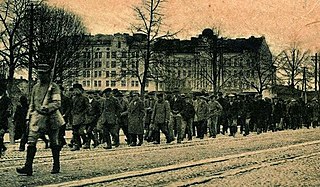
The Battle of Viipuri was a 1918 Finnish Civil War battle, fought 24–29 April between the Finnish Whites against the Finnish Reds in Viipuri. Together with the Battle of Tampere and Battle of Helsinki, it was one of the three major urban battles of the Finnish Civil War. The battle is also remembered because of its bloody aftermath, as the Whites executed up to 400 non-aligned military personnel and civilians of Russian and associated ethnicities.

Battle of Syrjäntaka was a 1918 Finnish Civil War battle fought 28–29 April in Syrjäntaka, Tuulos, between the German Baltic Sea Division and the Finnish Red Guards. Thousands of Red refugees were fleeing east, while they were blocked by a small unit of Germans in a highway crossing in the small village of Syrjäntaka. After hours of desperate fighting, the Reds managed to break through and continue their journey. Battle of Syrjäntaka and the preceding battle in Hauho were the only battles the Germans lost during their one-month military campaign in Finland. They were also the last Red victories of the Civil War. The battle itself was totally unnecessary. It had no effect to the result of the war and either side gained nothing as the Reds were captured only a couple of days later.
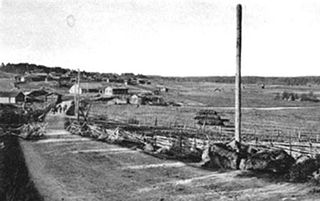
Battle of Antrea was a Finnish Civil War battle, fought in Antrea and Jääski, Finland in 11 February – 25 April 1918 between the Finnish Whites against the Finnish Reds.
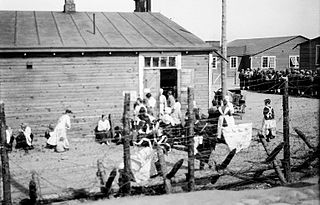
Tampere camp was a concentration camp operating from 6 April 1918 to 15 September 1918 in the Kaleva district of Tampere, Finland. It was set up for the Reds captured by the White Army after the Finnish Civil War Battle of Tampere.

The Invasion of Åland was a 1918 military campaign of World War I in Åland, Finland. The islands, still hosting Soviet Russian troops, were first invaded by Sweden in late February and then by the German Empire in early March. The conflict was also related to the Finnish Civil War including minor fighting between the Finnish Whites and the Finnish Reds.

All-female units of the paramilitary Red Guards served in the 1918 Finnish Civil War. The first Women's Guards units formed in early February in the main Finnish cities. More than 15 female Guards units were established by the end of March 1918, with a total of about 2,000 women serving. The female Guards units consisted of young industrial workers, maids, and servants. Their average age was about 20, but some were as young as 14. The women served in auxiliary units in combat.

The Battle of Länkipohja was a Finnish Civil War battle fought in the village of Länkipohja on 16 March 1918 between the Whites and the Reds. Together with the battles fought in Kuru, Ruovesi and Vilppula between 15 and 18 March, the Battle of Länkipohja was one of the first military operations related to the Battle of Tampere, which was the decisive battle of the Finnish Civil War. The battle is known for its bloody aftermath as the Whites executed 70–100 capitulated Reds. One of the executions was photographed and the images have become one of the best known pictures of the Finnish Civil War.

Battle of Vilppula was a Finnish Civil War battle fought in Vilppula and Ruovesi, Finland in 31 January – 18 March 1918 between the Whites and the Reds. Due to its location by the Tampere–Haapamäki railway, Vilppula was a gateway to the White controlled Central Finland. The Reds were aiming to Haapamäki, 25 kilometres north of Vilppula, which was a vital junction of the east–west railways connecting the regions of Ostrobothnia, Häme and Karelia. From Haapamäki, the Reds would be able to reach the White stronghold in Southern Ostrobothnia, including their capital Vaasa. However, the attack along the railway was stopped at the beginning of February. The Reds now turned their attention to the village of Väärinmaja in order to reach Vilppula from southwest by the road connecting Ruovesi and Vilppula. This offensive also failed, and finally on 15 March, the Whites launched their own offensive and the Reds retreated south to defend the city of Tampere.

The Battle of Ahvenkoski was fought during the Finnish Civil War between 10 April and 5 May 1918 at Ahvenkoski, Finland between the German Empire and the Red Guards of the Finnish Socialist Workers' Republic, more commonly known as Red Finland. For most of the battle both sides occupied trenches along the Kymi river. Ahvenkoski and the surrounding Kymi valley region were the last strongholds of the Reds. The battle ended with the surrender of the last of the Red Guards on 5 May, which ended the war with White Finland and Germany defeating Red Finland.
Anarchism in Finland dates back to the early revolutionary movements of the 20th century, seeing organized activity begin in the 1960s.

Teisko is a village and former municipality in Pirkanmaa region, Finland. It was consolidated in 1972 with Tampere, and at the same time Tampere got new districts: Kämmenniemi, Polso, Terälahti and Velaatta. Teisko's neighboring municipalities were Kangasala, Kuru, Orivesi, Ruovesi, Aitolahti and Ylöjärvi. Initially, the municipality comprised areas on both sides of Lake Näsijärvi, but in 1954, the areas west of Lake Näsijärvi were connected to Ylöjärvi and Kuru.
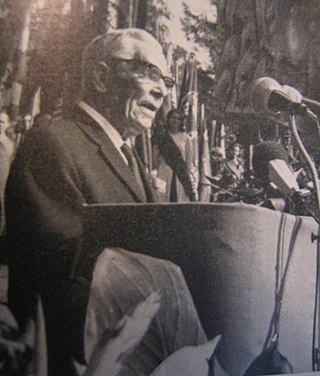
Gustav (Kusti) Ludvig Kulo was a Finnish politician who was the chairman of the Finnish People's Democratic League 1948–1966.

The Battle of Lempäälä refers to a series of battles within the Finnish Civil War, that took place within the areas of Lempäälä and neighboring Vesilahti.





















